
The TGV Duplex is a French high-speed train of the TGV family, manufactured by Alstom, and operated by the French national railway company SNCF. It is unique among TGV trains in that it features bi-level carriages. The Duplex inaugurated the third generation of TGV trainsets. It was specially designed to increase capacity on high-speed lines with saturated traffic. With two seating levels and a seating capacity of 508 passengers, the Duplex increases the passenger capacity. While the TGV Duplex started as a small component of the TGV fleet, it has become one of the system's workhorses.
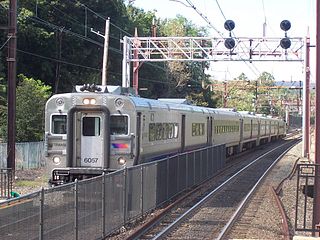
The Comet railcar is a class of locomotive-hauled railcars that was first designed in the late 1960s by Pullman-Standard as a modern commuter car for North American rail lines. Later, the Comet moniker was adopted by NJ Transit for all of its non-powered single level commuter coaches. Additional series of cars bearing the Comet name, based on the original design, have since been built by Bombardier Transportation and Alstom. The successful design was adopted by numerous commuter agencies.
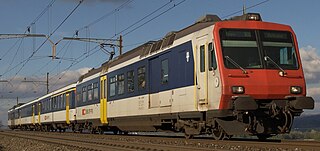
The RBDe 560 and its derivatives provide motive power for S-Bahn, suburban, and regional traffic on the Swiss Federal Railways (SBB) network. The derivative versions belong to the SBB as well as various private railroads. The locomotive and its matching Bt model Steuerwagen form compositions generally known as the Neuer Pendelzug, which is the source of the acronym NPZ. An NPZ trainset usually includes one or more intermediate cars.
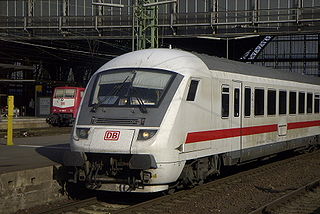
A control car, cab car, control trailer, or driving trailer is a non-powered rail vehicle from which a train can be operated. As dedicated vehicles or regular passenger cars, they have one or two driver compartments with all the controls and gauges required to remotely operate the locomotive, including exterior locomotive equipment such as horns, bells, ploughs, and lights. They also have communications and safety systems such as GSM-R or European Train Control System (ETCS). Control cars enable push-pull operation when located on the end of a train opposite its locomotive by allowing the train to reverse direction at a terminus without moving the locomotive or turning the train around.

The CRH1 EMU, also known as Hexie is a high-speed train operated by China Railway and built by a joint venture between Bombardier Transportation and Sifang at Bombardier Sifang Power Transportation factory in Qingdao, Shandong Province, People's Republic of China.

Stadler FLIRT is a passenger multiple unit trainset made by Stadler Rail of Switzerland. The baseline design of FLIRT is an electric multiple unit articulated trainset that can come in units of two to twelve cars with two to six motorized axles. The maximum speed is 200 km/h (124 mph). Standard floor height is 57 cm, but 78 cm high floors are also available for platform heights of 76 cm.

The CRH3 Hexie is a version of the Siemens Velaro high-speed train used in China on the Beijing–Tianjin intercity railway line, Wuhan-Guangzhou Passenger Dedicated Line, Zhengzhou-Xi'an Passenger Dedicated Line and the Shanghai–Nanjing intercity railway. It is capable of service speed of 380 km/h (236 mph) as the very similar Velaro E used in Spain, but, similarly to the Sapsan, it is 300 mm (11.8 in) wider to take advantage of a more generous structure gauge and thus be able to fit in more seats in a 2+3 layout.
The Tze-Chiang Express, also spelled "Tzu-chiang" or "Ziqiang" is a type of express train service operated by the Taiwan Railways Administration (TRA) in Taiwan. Of the five service classes operated by the TRA, the Tze-Chiang trains is the fastest category. Ticketing is done on the basis of mileage. This service is operated with 7 different trainsets: the E1000 series, the EMU1200, EMU3000, TEMU1000, DR2800, DR3100, and the TEMU2000. The now-retired EMU100 was the first trainset built for this service, which was used for 30 years, terminating ordinary runs at June 15, 2009.

The Stadler KISS is a family of bilevel electric multiple unit commuter trains developed and built since 2008 by Stadler Rail of Switzerland. As of 2016, 242 KISS trainsets comprising 1,145 cars have been sold to operators in eleven countries.

Zefiro is a family of high-speed passenger trains designed by Bombardier Transportation whose variants have top operating speeds of between 250 km/h (155 mph); 380 km/h (240 mph) and 400 km/h (250 mph).

81-717/714 is a metro car designed in the Soviet Union in the mid-1970s. The cars were made from 1976 to 2010 by Metrovagonmash and the I. E. Yegorov Vagonmash factories of Mytishchi and Saint Petersburg, respectively. Production is still ongoing for specific models and/or modernizations, and may possibly be the most produced and longest produced metro train in the world.
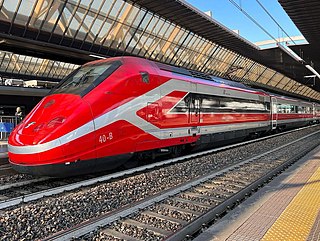
ETR 500 is a family of Italian high-speed trains built by AnsaldoBreda and introduced in 1993.

The 121 series (121系) is an electric multiple unit (EMU) train type introduced in March 1987 by Japanese National Railways (JNR), and currently operated by Shikoku Railway Company on local services in Shikoku, Japan.

The Genoa urban railway service is operated by Trenitalia on the lines around the city of Genoa.

The Treno Servizio Regionale (TSR) are a series of double-decker EMUs used by the Lombard railway company Trenord for the commuter services around Milan, and particularly for the suburban lines.
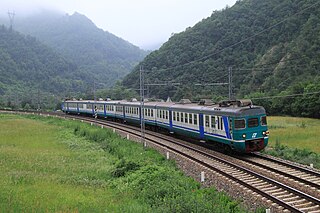
The ALe 801/940 are a series of EMUs built in the 1970s for the Italian state railway FS, now used by its successor, Trenitalia.

The EN 300 are a series of EMUs built in 1977 for the Italian railway company SEPSA, used on the commuter railways Circumflegrea and Cumana.

The ALe 724 are a class of EMUs of the Italian Ferrovie dello Stato, projected for suburban and regional services.

The ALe 582 is an Italian electric multiple unit train designed for commuter and medium-distance services, developed in the mid-1980s to replace pre-war and immediately post-war EMUs and locomotive-hauled trains on various lines in Sicily and Southern Italy, although they later diffused on the whole FS network. They're part of the "ALe Elettroniche" or "G.A.I." family, together with their predecessors ALe 724 and their successors, the ALe 642.

The Regio 2N is family of a double-deck, dual-voltage electric multiple unit trainsets built for French rail operator SNCF to serve its regional rail routes.




















